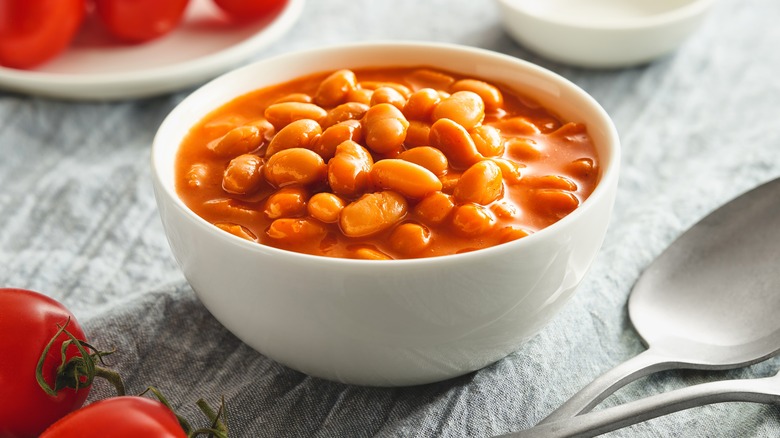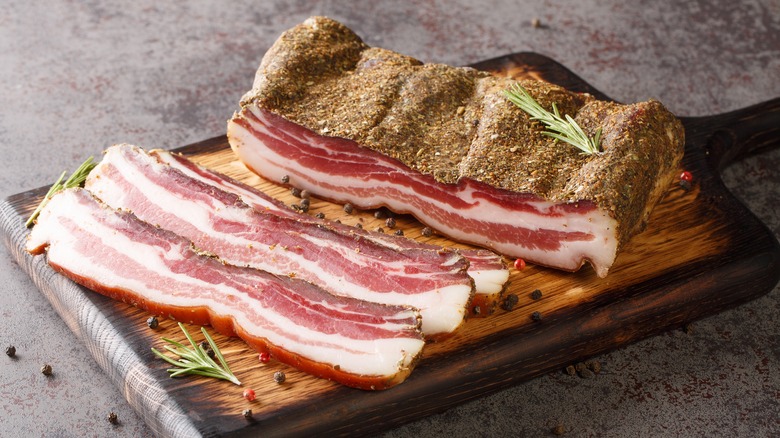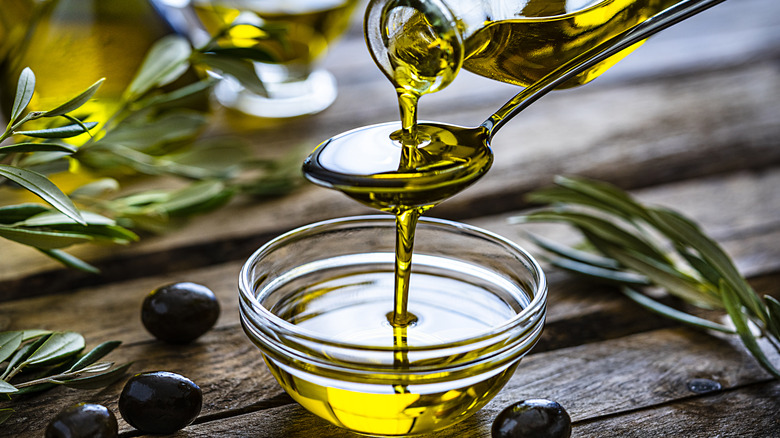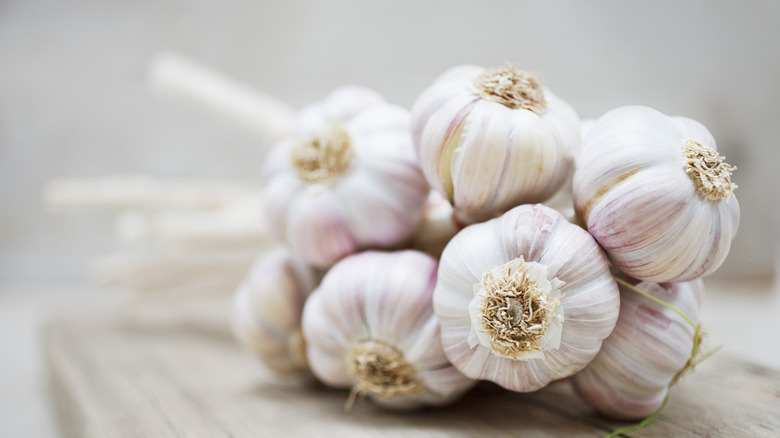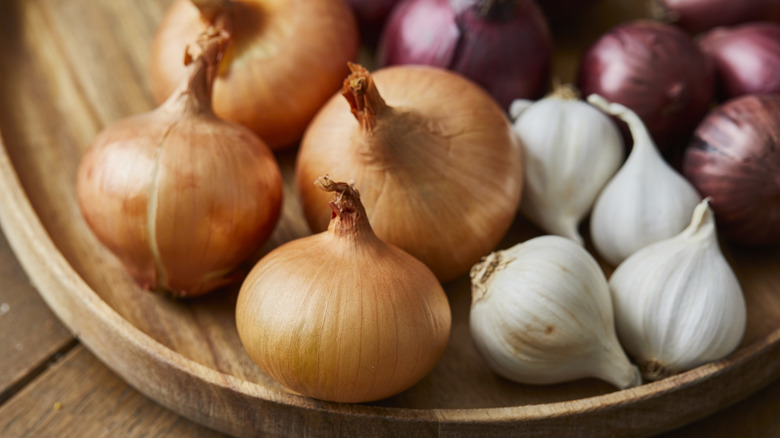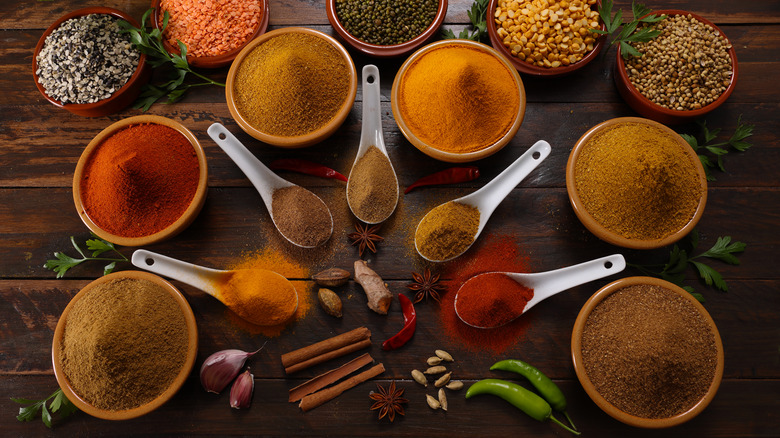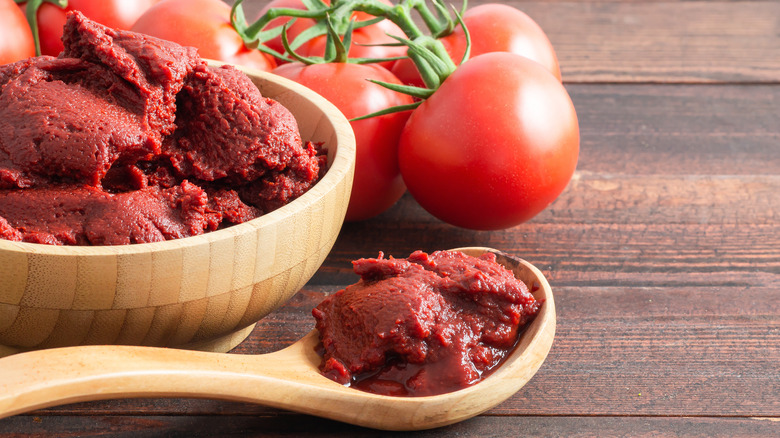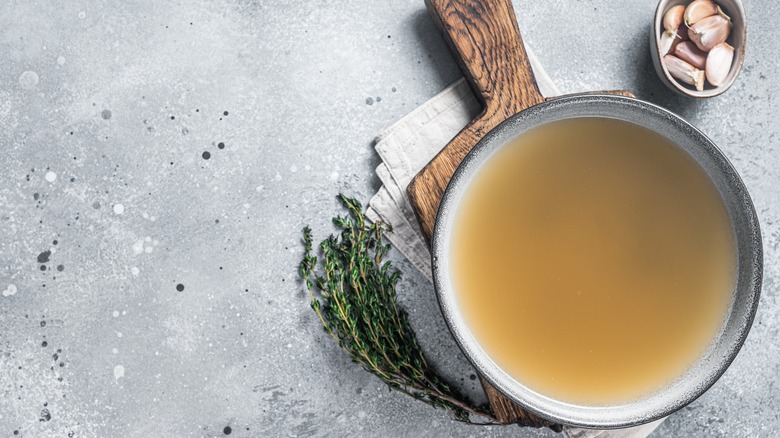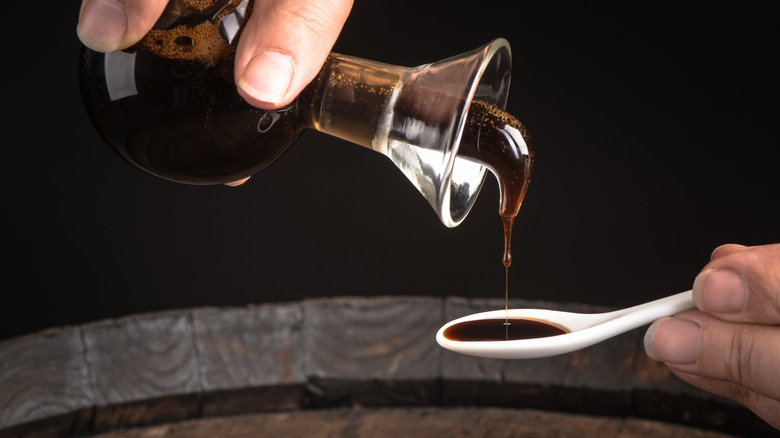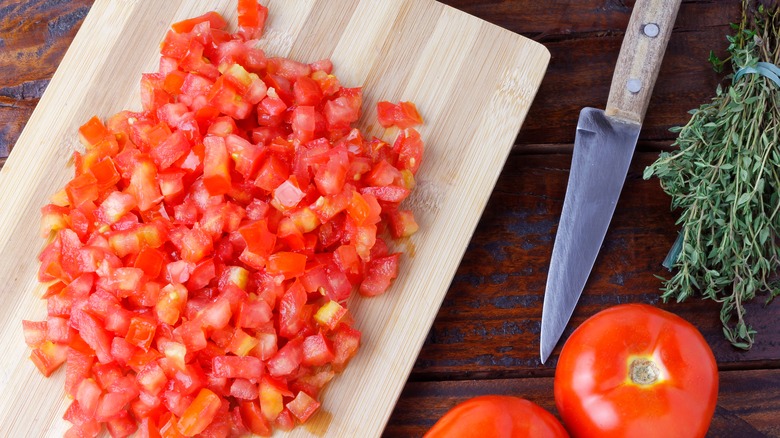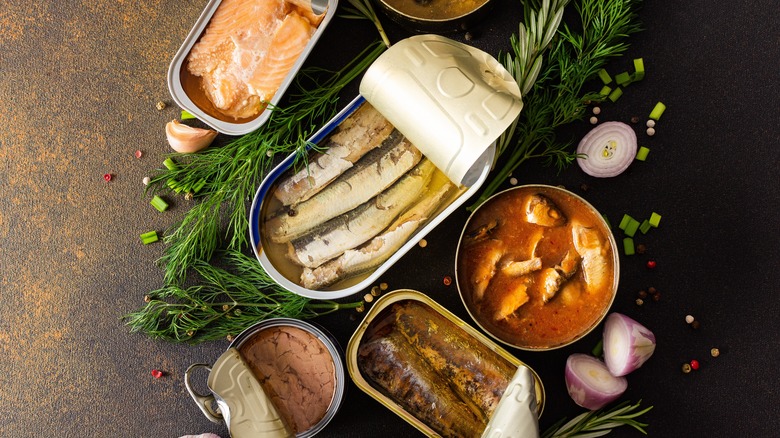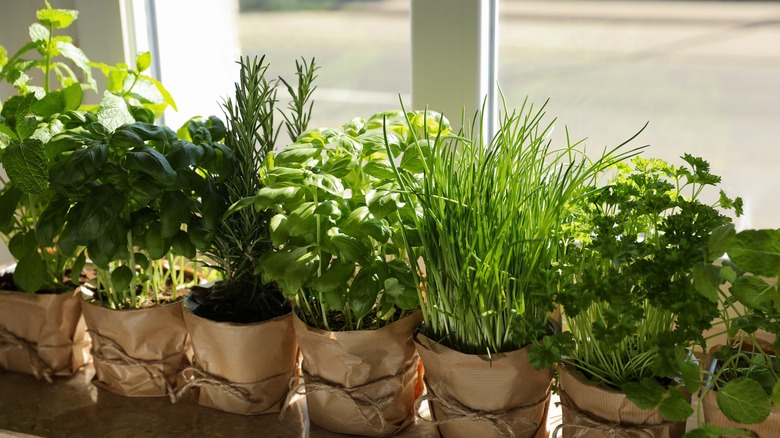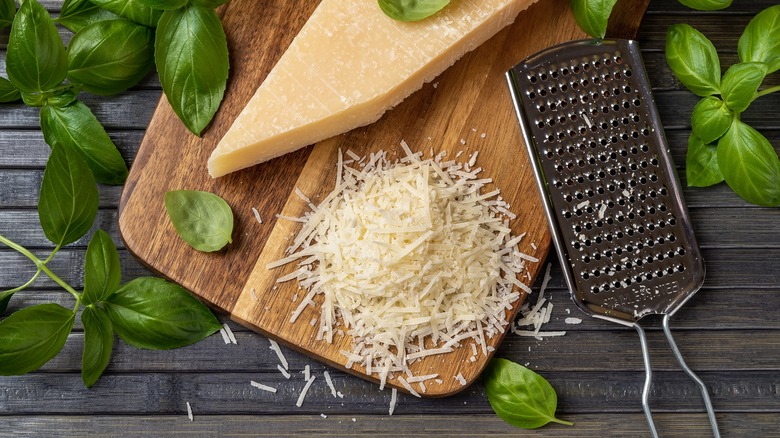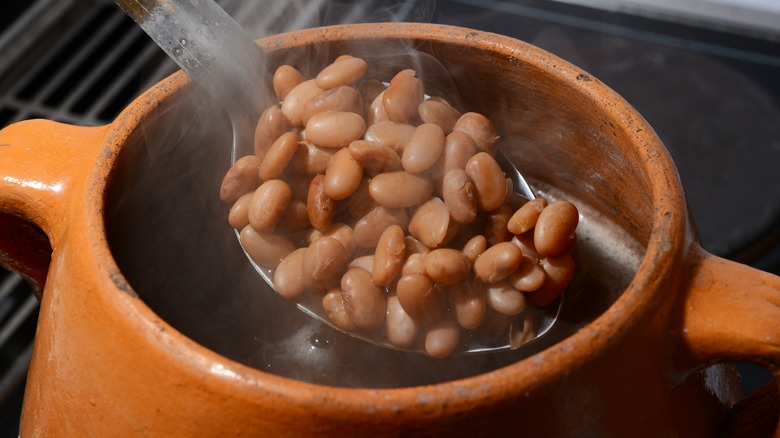Simple Ingredients That Take Canned Beans From Boring To Brilliant
Looking for a nutritious, delicious dinner? Beans are an easy pantry staple that can help you pull together a meal regardless of your level of cooking expertise. Packed with protein and fiber, beans are a healthy, delicious option for everything from soups to sauces. They are affordable, vegan, and versatile, appearing in many global cuisines.
Canned beans are even easier to utilize but have one significant downfall: For sensitive palates, canned beans taste mainly of the can and the heavily salted water and less of the bean's actual flavor. Once the beans are drained and rinsed carefully, the beans need some assistance. This need becomes even more pronounced if beans are meant to shine on their own and not be hidden in a soup or heavy pasta salad.
Fortunately, there are many ways to add flavor to bland beans. If you're having trouble figuring out how to make some magic happen with a boring can of beans, try adding one or more of these simple ingredients (and one magic cooking tool).
Bacon or pancetta
It's a wild culinary cliché to say that everything tastes better with bacon. However, it's an absolute truth that adding pork products to canned beans is one of the fastest ways to bump up the flavor with minimal effort. Why do beans taste better with added pork? The richness of the fat is the first reason, followed quickly by the smoky flavor and complexity that a thoughtfully cured piece of pork brings to the table.
Bacon or pancetta is an obvious choice. Start by cooking bacon or pancetta in the bean pot, rendering the fat out and crisping it up. You can remove the bacon and add a bit of liquid to scrape up the fond (those tasty bits stuck to the bottom of the pot) before proceeding, then crumble the bacon into the beans. Slab or thick-cut bacon can also be added raw for long-cooking bean preparations.
If you want to take the really hands-off approach, use a ham hock or trotters in a slow cooker with beans and other aromatics. This slowly releases everything delicious about pork into the dish. While most of the ham hock is inedible tendon and skin, small bits of meltingly soft pork remain after cooking. Pick those out and add them to the dish, too.
Olive oil
One secret of restaurant chefs and why their food tastes so good is their judicious use of fat to amp up flavor and mouthfeel. Canned beans tend to taste mildly tinny and dry straight out of the can, and they require a bit of fat to perk them up.
Olive oil is a great choice for boosting beans. The peppery bite of the oil plays nicely with mild beans (cannellini and northern beans especially) but also holds its own in more strongly flavored options (i.e., black beans). The key is picking the perfect oil. Pass by pale "light" olive oil for nearly all applications when trying to add flavor. These refined oils have only a fraction of the taste of their unrefined and cold-pressed counterparts (and aren't actually better for you).
If you add olive oil to canned beans during cooking, unrefined olive oil is a good choice. Cold-pressed extra virgin olive oil, that beautiful deep green liquid with subtle flavors that can be damaged by heat, is best drizzled onto the final dish when serving.
Garlic
Garlic makes nearly every canned bean dish better, but there are some guidelines to get the best results. The form of garlic is important here. Raw garlic is rarely the best application — it's too strong and overpowers every other flavor. Sautéed or roasted garlic transforms in flavor from something harsh and biting to a complex and almost sweet ingredient.
Garlic is an aromatic that, along with onions and other aromatics, creates a foundation upon which you continue to layer flavor. You aren't necessarily going for a dish that tastes strongly of garlic; rather, garlic adds a supporting undercurrent that brings harmony to all other ingredients. Sauté minced garlic in olive oil until fragrant before adding the beans for a savory kick, or roast whole heads of garlic in olive oil until soft and fragrant, remove from paper husks, and then stir the creamy roasted garlic into the finished dish.
Onion
Onions are an amazing option when it comes to bumping up the flavor of canned beans. There is a wide variety of alliums to choose from, and the one you choose often dictates how you use it.
For example, onions sautéed quickly at the beginning of a dish are not meant to stand out. They let bold flavors and spices shine through. In other instances, onions might be one of the main ingredients. Caramelized onions, for example, bring balance and sweetness while also adding a bit of smoky char. This is an excellent option when the canned beans are a grace note rather than the central tune.
For dishes with longer cooking times, such as Boston baked beans, raw, chopped onion gets tossed right into the pot to cook alongside the beans and other ingredients. This slow cooking breaks the onion down and transforms the dish as it cooks. Onions in any form also flavor the bean broth and make it something to savor, not discard.
Spices
The quickest way to add flavor to canned beans is to literally add flavor in the form of spices. Spices were originally added to food to mask the taste of less-than-fresh ingredients and have long been prized as currency and for trade. Formerly rare spices like cumin, chile, and cinnamon are now available at the corner market.
These days, you're less likely to hide the funk of a slightly spoiled cut of meat than you are to visit other culinary regions of the world with a perfectly calibrated blend of spices. The combinations are endless — a quick study of flavor profiles from other countries can guide you.
Spices can be added whole or in dried and powdered form. Whole seeds such as coriander, cumin, and mustard can be sizzled in oil or dried toasted to really bring out the flavor before crushing and adding to the dish. Powdered herbs should be added after the aromatics (garlic and onion) are sautéed. Cook gently for one minute to let them bloom and release their fragrant oils.
You can also purchase whole spices and grate or grind them directly into the dish. This tends to result in the freshest, most vibrant flavor. But whatever you do, don't neglect to add the most important seasonings of all: salt and pepper. If you add nothing else, salt and pepper, when used correctly, breathe new life into canned beans.
Tomato paste
Tomato paste is one of those overlooked, underutilized ingredients that professional chefs keep in their back pockets (and home cooks end up throwing out after using a random tablespoon out of the can). This humble ingredient consists of tomatoes cooked over several hours, passed through a food mill to remove seeds and skins, and then cooked again to further remove cooking liquid until a thick, dark red paste remains. The result is a richly flavored umami bomb that also lends brightness and acidity.
To properly use tomato paste in a canned bean dish that anyone can fall in love with, add a spoonful or two of tomato paste at the same time you bloom your dried spices. Cooking tomato paste briefly before adding liquid or other ingredients removes the raw flavor. If you're using paste from a tube, simply cap the tube and store it in the fridge, but don't run the risk of mold in a poorly sealed can of paste. To preserve leftover canned tomato paste, pack it into ice cube trays and freeze.
Stock, broth, or beer
Most people reach for water when cooking dried beans and making soup from canned beans. But why? Water brings nothing to the party and can result in a diluted-tasting dish. Stock, broth, or beer are the simplest substitutions for an immediate bump in flavor.
It doesn't matter how much liquid a recipe calls for. In most cases, you can easily substitute stock or broth in equal amounts. Even better? Pull a Giada and add a beer to your favorite baked bean recipe. The rich notes of dark beer, in particular, work well with smoky baked beans, but lighter beers pair well with lighter recipes — think pale ales with white beans. Keep in mind that beer has gluten, so skip this addition if you are cooking for celiac or gluten-sensitive people.
Consider also making your own stock or broth. This allows you to customize your cooking liquid and is a great way to use vegetable scraps for vegan stock; you can also use the carcass of a roast chicken, leftover hambones, and ribs for delicious meat-based stocks and broths.
Balsamic vinegar
Vinegar is an underutilized kitchen workhorse. Vinegar has superpowers that go far beyond adding tartness to your favorite vinaigrette. It breaks down proteins in meat to help tenderize them, and it also adds a sour flavor component that balances richness. While canned beans on their own are not necessarily a rich-tasting ingredient, many recipes turn them into something stodgy and heavy. Vinegar adds a punch of tartness that lifts the weight of the other ingredients, magically enhancing and balancing spice and salt.
The variety of vinegar you use has a different effect, so choose carefully. A high-quality, syrupy balsamic lends sweetness to a dish and should be drizzled on when beans are served, but a quick splash of apple cider or red wine vinegar can be used on canned beans in cold dishes or as an additive during the final moments of cooking.
Adding vinegar is a better way to balance flavor. Inexperienced cooks may reach for salt when dishes are bland, but acidity is often more important. If your canned bean dish tastes like something is missing, try a tablespoon of vinegar before reaching for the salt pig.
Diced tomatoes
Are you sensing a trend here? Canned beans do have their own flavor profile, but adding certain ingredients lifts what's hidden into plain view. Diced tomatoes are one such ingredient. These add a freshness and acidity that highlights what's there instead of glossing over it.
Diced tomatoes also add a lovely texture contrast to the creaminess of the beans. Canned tomatoes work fine, but they are better for dishes that will be cooked for longer periods. Longer cooking deepens their flavor a bit and breaks down tougher tomatoes. Definitely splurge in the summer on the freshest farmstand tomatoes for their sweetness and juice. Use fresh tomatoes in cold bean dishes to highlight their summer sunshine.
Whatever you do, don't use winter hothouse tomatoes. They have no flavor and a challenging texture (often mealy and without juice). The price is often double the summer price, and they just don't add anything to your dish.
Canned fish
Simple summer salads start with canned beans and tinned fish. Tinned fish — tuna, anchovies, and sardines — pair exceptionally well with white beans of almost every variety. Think of this as Mediterranean cuisine in the height of the summer: effortless, acidic, cold, and delicious.
Some of the best anchovies in the world are harvested right off the tip of Italy's boot; add them to a beautiful salad of cannellini beans, parmesan, lemon, and best-quality olive oil. Tuna, red onion, white beans, and red wine vinegar make a delightfully Tuscan dinner; substitute fresh tuna and add tomatoes for a delicious baked entrée.
Key to these combinations is the addition of acid in the form of vinegar, lemon juice, or some kind of citrus zest. The highest quality canned fish is often packed in oil, and a generous hand with acidity (plus fresh herbs, see below) helps lighten up the dish. This also helps if you use beans and canned fish in a heavier dish such as pasta.
Fresh and dried herbs
Fresh and dried herbs make every dish better. They are used at different times during cooking to different effects, and using a different form of the same herb — like adding dried coriander while cooking and adding fresh cilantro when serving — can have a surprising effect on the final dish.
Dried herbs are used when cooking in much the same way spices are. You'll need to add them early in the cooking, right after the aromatics are cooked, and allow them to cook gently for a minute or two. Adding dried herbs later in the process is possible, but they will be less effective in flavoring boring beans. When adding, rub the dried herbs between your fingers to release their oils. If you use herbs on woody stems (i.e., rosemary, thyme, bay leaves, or sage), tie them in a bundle (or place them in a mesh bag or cheesecloth). The French called this a bouquet garni — it's a way to add the flavor of the herbs but allow for easy removal after cooking.
Fresh herbs should be added after cooking, but these are not the dreaded non-edible garnish. Chop the herbs and sprinkle over the beans for a burst of freshness when you serve. Cilantro, basil, and mint are all excellent options.
Cheese
Let's be honest: Cheese makes most things better, and canned beans are no different. Cheese adds both flavor and creamy texture to sad canned beans, sometimes in surprising ways. For example, if you find yourself with a can of refried beans that need a little help, stirring in a hunk of cream cheese and some shredded colby jack cheese punches them up.
But that's not the only way to add cheese to beans. The Brits layer extra sharp aged cheddar on beans over toast and send the whole thing for a trip under the broiler to melt. Cotija cheese is a standard addition to pinto beans in Mexican cuisine, and a bean-and-cheese burrito is standard late-night fare pretty much everywhere you look on a college campus. Other great canned bean and cheese pairings include black beans with manchego, white beans with thinly shaved parmesan, and chickpeas baked with feta and tomatoes (or the same dish cold with fresh tomatoes and feta).
Clay pot
Finally, one of the best ways to turn your canned beans from boring to brilliant is by changing your cooking vessel. The best cooks understand how technique can make or break a dish; the same can be said of your cooking tools. Cooking beans in a clay pot adds flavor to them in a way that a metal pan simply cannot.
How does this happen? The degree of flavor depends largely on the pot type and the cooking method. Traditionally made clay pots are shaped by hand and dried before the potter scrapes them smooth and finishes the interior by rubbing them with stones. Just as grapes and vegetables taste different depending on where they are grown, traditional hand-made clay pots are infused with the terroir of their region. The minerals in the clay are released during cooking, adding flavor and depth to whatever is in the pot.
And the flavors of the pot combine as the beans cook. Clay pot cooking is used for long, slow braises, a process that extracts the most flavor from ingredients as they combine in the pot. Over time and with use, this patina of flavor deepens and gets even richer. Canned beans won't cook for the same hours that a large roast might, but even a 45-minute trip in the clay pot can remarkably affect the flavor.

